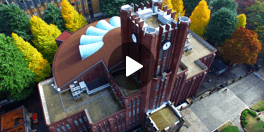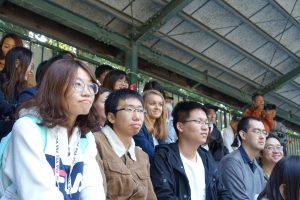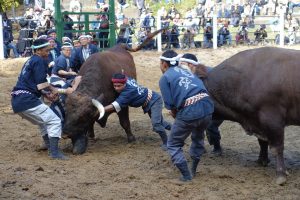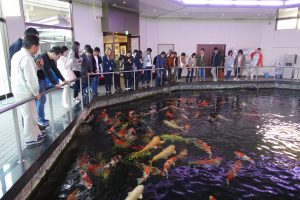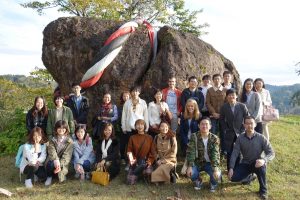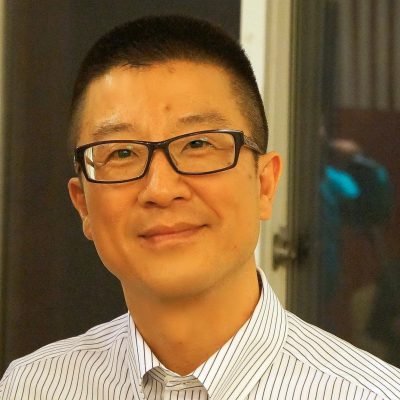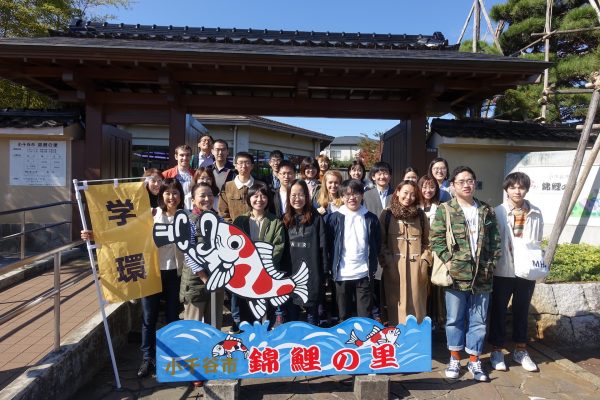
November 29, 2018
2018年 留学生旅行「小千谷市 牛の角突き観戦」GSII Tour 2018 “Bullfighting in Ojiya”
11月4日(日)朝8時、留学生22名と教職員5名は、貸切バスで日帰り旅行に出発しました。今回の目的地は、遠く新潟県は小千谷市。国の重要無形民俗文化財に指定されている「牛の角突き」観戦のため、一路新潟を目指しました。
旅行に先立ち、プレセミナーも実施されました。伝統文化や民俗学を研究され、学生・留学生委員で自らも角突きの牛を一頭所有しておられる菅先生によるものでした。当日は、この事前セミナーに参加できなかった学生の為に、学生・留学生委員長の池亀先生から、角突きの説明や新潟についてのお話があり、まずは車内で自己紹介。新潟に近づくにつれて青空が広がり、紅葉の山々に感嘆の声をあげながらの4時間。そして最初の目的地である小千谷市サンプラザに到着し、特別に用意された昼食を美味しく頂きました。
食事後はすぐに闘牛場へ。観客席はすでに多くの人々で埋まっていました。そして角突きの最中にもかかわらず、ねじり鉢巻きに法被姿の菅先生にわざわざ出迎えて頂きました。会場では一つひとつの取り組みの説明もあって分かり易く、1トンもの闘牛の角突きはさすがの迫力でした。いよいよ菅先生がお持ちの横綱牛の出番では、地元の勢子を務める人達に溶け込んで横綱牛の綱を引く菅先生はとても生き生きとされていました。時々歓声をあげて、皆初めての角突きに興奮と満足の2時間程を過ごしました。
再びサンプラザに戻って、最後に隣接の「錦鯉の里」を見学しました。係員の方から、世界から買い付けに来るという錦鯉の説明を聞きながらしばし錦鯉鑑賞。日本庭園を散策して写真を撮り合ったり、お土産を買ったりして、短い新潟滞在ではありましたが、午後4時に帰路に着きました。途中渋滞もありましたが、予定の1時間遅れで無事本郷に辿り着いたのが夜の9時。行きよりくつろいだ雰囲気で、普段交流の無い学生達が勉学を離れてネットワークを作ることができ、それぞれに楽しい思い出のできた充実の一日でした。
事後アンケートでも、すべての参加者が「大変満足」または「満足」と回答しており、「日本文化の理解をより一層深めた」「バスの道中が、友人と深い会話をする良い機会となった」「日本の闘牛は残酷ではなく牛が大切にされていてよかった」といった声が多く寄せられて、今回のバス旅行が有意義な体験になったことが分かります。
記事:村田玲子(学務係)
英文翻訳:デイビッド・ビュースト(特任専門員)
At 8 a.m. on November 4th, 22 international students and 5 members of staff set out on a daytrip by chartered bus for Ojiya in Niigata Prefecture. The object of the trip was to view the traditional “bullfighting” held in that city, which has been officially designated as one of the “Important Intangible Folk Cultural Properties of Japan.” Prior to the trip, the participants had attended a pre-seminar organized by Professor Yutaka Suga of the III, who is not only an expert on vernacular culture and folklore but also the owner of a fighting bull.
When they arrived, the stands at the bullfighting ring were already full of spectators. Prof. Suga took the trouble to come out and greet the tour party despite the bullfighting being already in progress. The explanations of the proceedings were easy to follow, and the power of the bulls, weighing as much as a ton, was truly impressive.
At the end of the trip, the participants visited a facility called “Nishikigoi no Sato,” which is dedicated to the colorful carp fish known as “Nishikigoi.” Besides looking at the fish, the visitors heard explanations from the staff, walked around the Japanese garden and bought souvenirs, before embarking on their return journey at 4 p.m.
Here are a few comments about the trip obtained from a questionnaire conducted afterwards: “My understanding of Japanese culture deepened.” “While traveling on the bus, I had a good opportunity to have deep conversations with friends.” “Japanese bullfighting is not cruel, and the bulls are well cared for.” Daytrips like this provide an opportunity for students to take a break from their studies and form a deeper social network among themselves. It was a fulfilling day leaving many cherished memories.
Text: Reiko Murata (Academic affairs division)
Translation: David Buist (Project senior specialist)
主担当教員Associated Faculty Members
教授
非公開: 菅 豊
Professor

